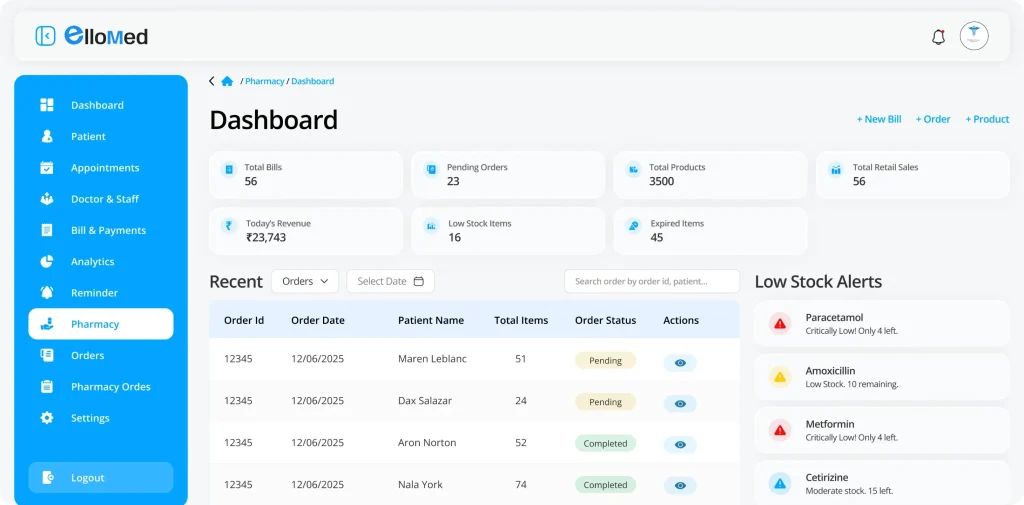How DevOps Coordination Reduces Downtime During Critical Deployments

At the time of deployments, when downtime hits that is just not a technical issue – it involves cost, loss of revenue, frustrated customers and damage to brand reputation. That’s why good DevOps coordination matters. When development and operation teams work in coordination with clear thoughts and strategies risk is reduced and deployments become stress-free and the project is delivered without interruptions and zero downtime.
Why Downtime Happens During Deployments
Every organization or DevOps team faces downtime issues once a while when publishing updates to production environments. Below are the most common reasons are:
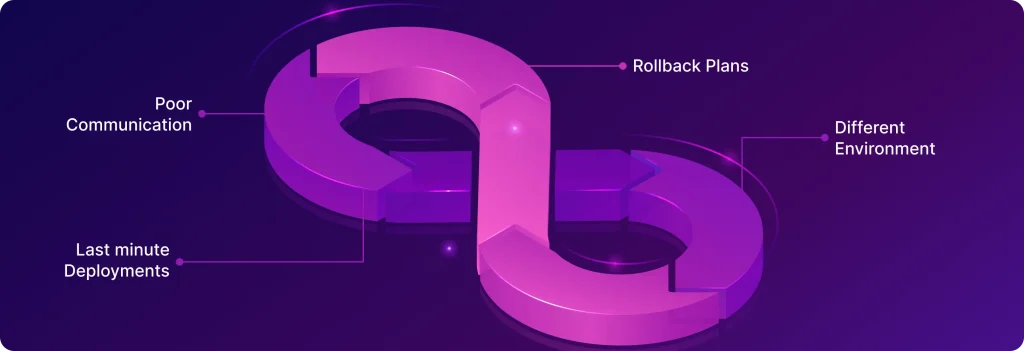
- Poor communication – Development, QA and Devops teams are not aligned on what is going to deploy.
- Rollback Plans – No clear rollback plan, which makes recovery slow and creates a mess if something goes wrong.
- Different Environment – Differences between staging and production environments, causing surprises after release.
- Last minute Deployments – Last-minute, untested changes that slip past quality checks.
The Role of DevOps Coordination
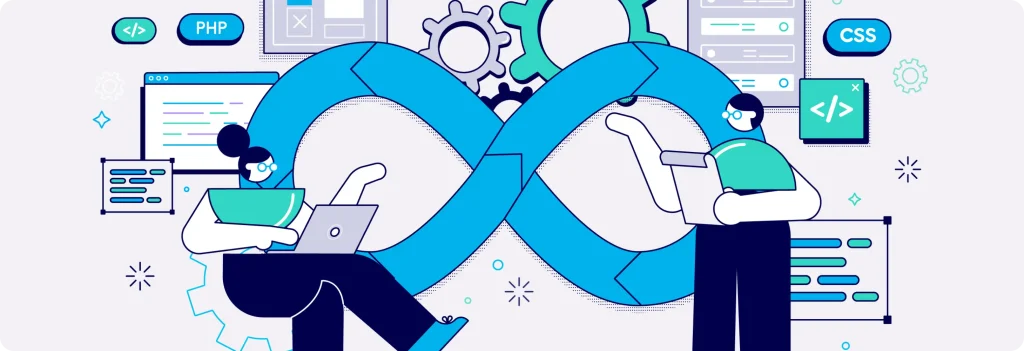
The word DevOps isn’t just about different tools — it’s about teamwork, automation, and a culture of shared responsibility. When done right, DevOps coordination plays a huge role in keeping downtime to a minimum:
- Reliable Rollback Plans: At the time of downtime, or when we get any hint that something is going wrong in production, the first thing required is a rollback plan. Because in production we can’t wait for the dev team to solve the issues, a well-defined rollback plan allows teams to quickly revert to a stable version, reducing recovery time and keeping downtime minimal.
- Better Communication : The coordination between the Development , Operations and QA team is very important. Everyone should know what’s being deployed , the risks involved and the fallback steps if something goes wrong.
- Automated CI/CD Pipelines: In today’s fast-paced environment, automation is essential not only to reduce the time that manual deployment takes, but also to eliminate the chance of human error. With integrated testing, security checks, and approvals, CI/CD pipelines ensure safe and consistent deployments
- Smarter Deployment Strategies
Blue-green deployments and canary releases make it possible to roll out updates gradually or in isolated environments, catching issues before they affect all users. - Real-Time Monitoring & Quick Response: Monitoring tools like CloudWatch, Prometheus, or the ELK Stack provide instant visibility into system health. Alerts and on-call coordination allow teams to act fast before small glitches turn into major outages.
Advanced Deployment Strategies
One of the strengths of DevOps is the ability to deploy new code without taking systems offline. Teams rely on proven strategies that introduce updates gradually and safely, ensuring zero downtime to users.
- Blue/Green Deployment
Two identical environments (Blue and Green) run in parallel. One serves live traffic (say Blue), while the other (Green) stays idle. The new release is deployed to Green, tested thoroughly, and then traffic is switched over. If issues pop up, switching back to Blue provides an instant rollback. - Canary Deployment
Instead of releasing updates to everyone at once, a small set of users (the “canary”) gets the new version first. Teams monitor performance closely, and if everything looks good, the rollout expands gradually. This way, any problem only affects a limited group before being fixed. - Rolling Updates
Updates are applied to a few servers at a time, replacing old versions with new ones. Since some servers keep running the old version while others move to the new one, the service stays up and available throughout the process.
Real-World Impact of DevOps Coordination
Imagine a large e-commerce company rolling out a critical update just before a big sales event. Without proper DevOps coordination, even a small glitch could bring the site down, blocking thousands of transactions and frustrating customers.
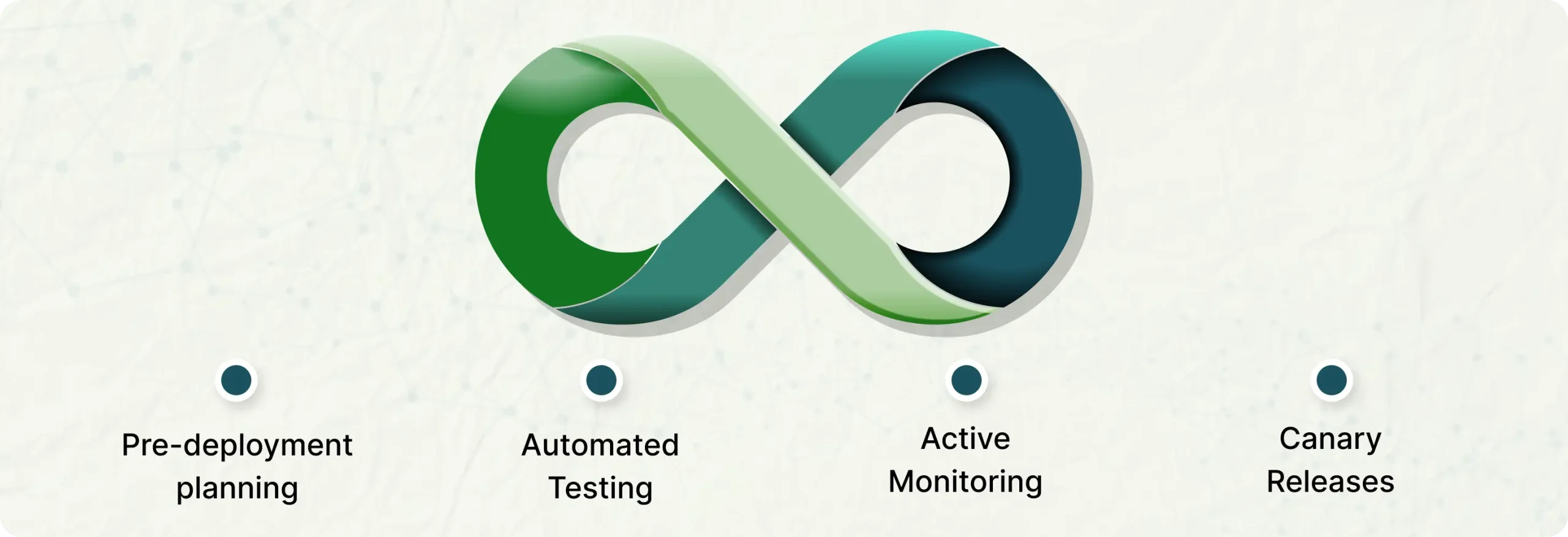
Now, picture the same deployment with DevOps practices in place:
- Pre-deployment planning keeps development and operations teams aligned and rollback plans are ready.
- Automated testing catches issues early before they hit production.Don’t deploy to production until all the test cases have passed.
- Canary releases let updates roll out gradually, so only a small group of users is affected if something goes wrong.
- Active monitoring spots incidents instantly, giving teams time to fix them before they escalate.
The result? The update goes live smoothly, customers shop without disruption, and the business avoids a costly outage.
Best Practices for Teams
- Maintain a checklist of tasks – Write proper steps for the deployment process. That include strategy for zero down time and predictable risks to reduce the mistakes over production environment
- Release notes – With good release notes we can safely deploy new functionalities to the live environment and quickly turn off the functionality if something went wrong.
- Shared dashboards for logs and metrics – Create a good logs and metrics dashboard like(AWS cloudwatch dashboard) to monitor the application logs and server metrics that helps teams to spot the issues and resolve them fast.
- Feedback and Reviews – After each deployment, we have to review what went well and what didn’t to keep improving our infrastructure and approach.
Final Thoughts
Downtime during critical deployments can happen but don’t make deployment processes stressful by poor coordination instead make it a well managed process by proper DevOps mindset.
Don’t let deployment downtime cost your business revenue and customer trust. Ellocent Labs helps organizations achieve zero-downtime deployments through proven DevOps coordination practices. Learn how we can help transform your deployment process.
Related Blogs

The requirements under Agile development will not be any different, but when. This will either turn into a nightmare or a chance of the designers of the UI/UX. It lies in the structure of the design process. The product will not be shaky, inconveniencing, and difficult to modify even though the requirements are to be changed as it is planned by a well-planned UI/UX.
Shaping a Reusable Foundation
In Agile as a UI/UX designer, one of the most intelligent things I would do will be to develop default design items, which will be uniform throughout the product. These reusable units which are buttons, input fields, modals, and patterns of navigation are the DNA of the design system.
- They are also useful in time savings as they do not need to rework each time they start off on a sprint.
- They offer a visual homogeneity of the product.
- They make the task of the developers easier because they would not be required to go through the new design repeatedly.
And consider it to be the creation of a design language, which never loses its grammar, but gains it.
Paper to Prototype Drafting Process
In Agile, speed matters. That is why it is better to start with rough drafts and plunge into tools.

Step 1: Paper and pencil, Plus Raw and unrefined test of user flows and positioning of constituents.
Step 2: Low-fidelity wireframes: Finding meaning without thinking of design.
Step 3: Illustrate drafts in working interfaces with the help of Figma prototyping.
It implies that this stratified design suggests that the designs will be tested during the early phases and will be enhanced later during the extensive rework costs will be saved in the long-term.
Case in Point: Ellomed
In the case of Ellomed (a system of Electronic Health Records), the project was originally created with a straightforward concept of managing the physicians, clinics, and appointments. However, according to Agile, the requirements continued to be updated, such as pharmacy integration, patient documents, inventory management, etc.
UI/UX coordination helped in keeping the system on track; it did so in the following manner:
- Reusable Components: We specified the standard fields, dashboard cards, buttons, alerts, etc. They did not improve on their components by reusing them when introducing new features. This enhanced the integration as well as productivity of the UI.
- Stability Over Adaptability: The evolving needs did not bring about the destruction of the already existing module but how to insert the other modules and not to completely break down the existing one.
- A good disposition to the user: The designs were all tested on a real user need basis. A case in point is in the pharmacy module where the date of drugs was automatically highlighted in red where it had expired. It was not all that was related to the aesthetic element, but simplifying and accelerating working processes.
Concisely, the need to start afresh was not the foundation of the sound basis of design adaptability.
Ideas of Agile Best Practices of UI/UX Designers
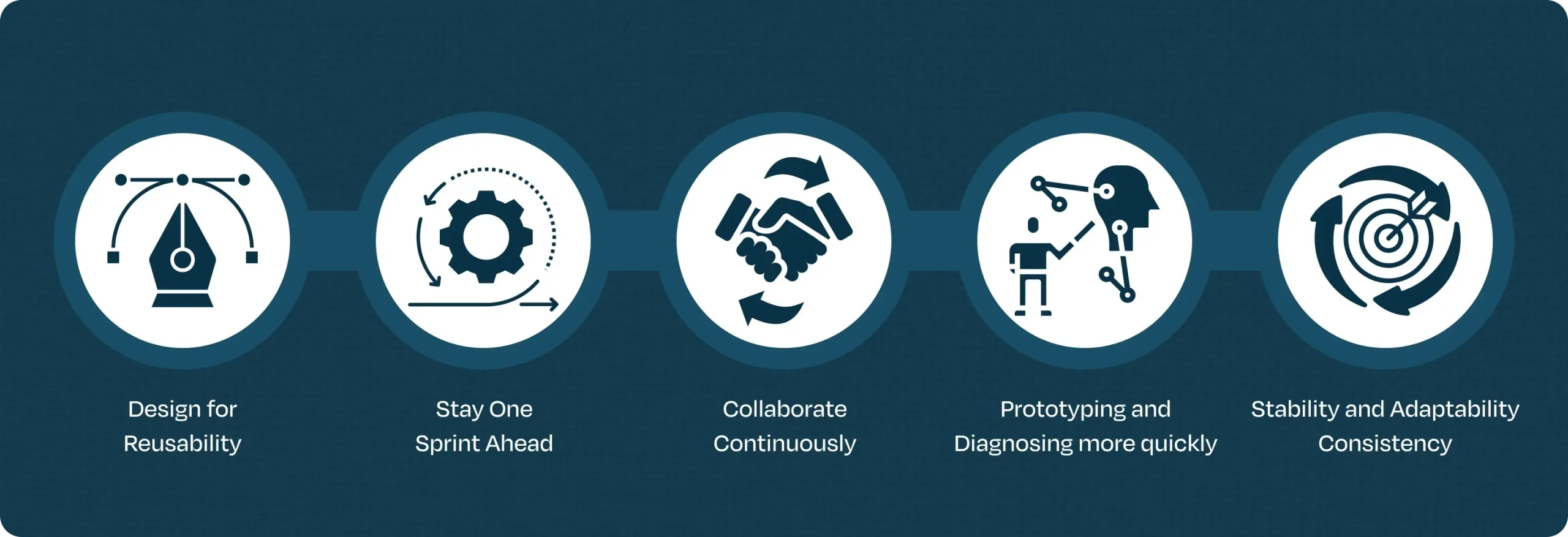
- Design for Reusability: Early analysis of component library. Imagine it to be your LEGO box, you can do anything with it, but the pieces are the same.
- Stay One Sprint Ahead: Plan the next sprint as the current one being developed. This will make sure that it is not rushed.
- Collaborate Continuously: Keep up with BAs, developing and testing. Five minutes talk will save five days of re-work.
- Prototyping and Diagnosing more quickly: The correct moment will never be to wait, to get feedback regarding drafts, and to click prototypes whenever it is possible.
- Stability and Adaptability Consistency: These design principles must be accommodated to cater to the new needs in a non-imposing manner.
Conclusion
Agile does not require the presence of UI/UX coordination in order to make interfaces appealing. It is concerning the way of developing systems that could fit the change and still remain themselves. The designers are able to cope with the challenges that occur due to change of requirements, which they could center on reusable components, draft-first design, and constant teamwork, hence, transform it into an opportunity, rather than a failure.
Practical experience with enterprises indicated that structured UI/UX causes agility to become a natural process – and the final result is not only an efficient system, but also a stable and easy to use system, coupled with being able to survive into the future.
Transform your UI/UX collaboration with Agile best practices. Ellocent Labs offers tailored workshops and hands-on support. Get started now for more efficient, adaptable interfaces.

The decision between a template and a custom web design is based on your budget, schedule, and business objectives. Custom web designs are tailored to your brand, offering enhanced scalability, security, and long-term growth flexibility. In contrast, templates enable rapid, low-cost launches with basic features.
Template Web Design:
Pros:
- Budget-Friendly: Templates are affordable, particularly for new and small enterprises. You don’t have to spend a lot of money on design and development to launch a respectable-looking website.
- Ready to Launch: Just add content and make minor adjustments before launching the templates. They are therefore perfect for companies seeking a rapid online presence.
- Requires Minimal IT Help: You can avoid hiring developers by using drag-and-drop builders and easy customization tools, which allow anyone with rudimentary computer skills to set up a website.
- Reliable Updates: To keep your website operating smoothly, designers frequently update templates to stay compatible with the newest web standards and technologies.
- Wide Range of Options: Whether you’re a blogger, restaurant owner, or retailer, there’s probably a theme that will work for you among the hundreds of themes available for various industries.
- User-Friendly Plugins: The majority of templates allow for the addition of practical features without knowing any code, thanks to support for well-known plugins like image sliders, social media feeds, and contact forms.
- Third-Party App Integration: To help you manage your business efficiently, templates typically offer built-in integration with necessary apps like analytics, email marketing tools, and payment gateways.
- Clear Structural Layout: Templates offer an organized framework that makes it simpler to edit and arrange your content by assisting you in visualizing how your website will appear.

Cons:
- Lack of Uniqueness: Your website may resemble that of others, as numerous companies utilize the same templates, thereby making it difficult to distinguish oneself in a competitive market.
- Limited Customization: If the template has locked features, you might not be able to modify certain components, such as layout or functionality, to meet your precise requirements.
- Limited Functionality: You might not be able to provide distinctive user experiences if you don’t support advanced features like product filtering or custom booking systems.
- Security Issues: Many templates rely on third-party plugins that may not receive regular updates, which can leave your website vulnerable to malware or hacking attempts.
- Not Always Friendly to SEO: Some templates contain poorly organized or bloated code, which can lower the visibility and ranking of your website in search results.
- May Not Be Fully Mobile-Responsive: Poor user experiences and increased bounce rates on mobile devices may result from templates that don’t adapt well to smartphones and tablets.
- Limited Support: If the template is free or was created by a small team without a dedicated help desk, you might have trouble getting technical support.
- Lacks Professional Feel: Custom-built websites may appear more polished and brand-aligned than template-based ones, which may affect how people view your company.
Custom Web Design:
Pros:
- Unique and Branded Design: Your website is created from the ground up to reflect the essence of your business, giving you a genuinely unique appearance and feel that makes you stand out.
- Flexible and Adaptable: All aspects of the website, including features and layout, are completely customizable. This makes sure your website works the way you want it to.
- Tailored to Business Needs: Whether you require particular user journeys, integrations, or performance enhancements, custom websites are constructed around your objectives.
- Improved User Experience: By streamlining the user journey for your audience, you can make the website quick, easy, and pleasurable, which will increase engagement and conversions.
- SEO-Friendly Architecture: Custom designs make use of SEO best practices and clean, optimized code, increasing the likelihood that your website will rank higher in search engine results.
- Highly Customizable Features: Include intricate components made especially for your audience, such as interactive product catalogs, booking engines, or custom calculators.
- Scalable for Growth: A specially designed website can readily expand to accommodate your company’s needs. You don’t have to start over when adding new features, sections, or integrations.
- Increased Security: Custom websites are more secure and less hackable when developers limit third-party plugins and follow stricter coding techniques.

Cons:
- Higher Development Costs: Compared to using templates, custom design necessitates a larger financial investment due to the involvement of designers and developers.
- Needs a Skilled Team: Unlike do-it-yourself options, you will need a team of professionals to design, build, and maintain your website, which may require more resources.
- Requires Constant Maintenance: As technology and user demands change, a custom website will require frequent updates to stay safe and operational.
- Time-Intensive Process: Creating a custom website requires patience and time, typically ranging from weeks to months, from research and wireframing to testing and deployment.
Conclusion:
Your short- and long-term objectives should guide your decision between a template and a custom web design. Templates are a good place to start if you need a quick, inexpensive, and easy solution. However, if you want a digital presence that is highly professional, scalable, and brand-focused, investing in a custom-built website will provide the performance and flexibility your company deserves.

AI projects can be small. We generate an idea in a team. Can we predict customer churn? Can we detect fraud? Can we improve delivery routes? We built a quick prototype (proof-of-concept) that shows promise.
But the real challenge is not building that first model. The real issue is to make it something dependable, trusted, and used every day throughout the entire organization. It is on the path between idea and production at scale that the real worth of AI opens up.
From Idea to Real Business Value
A prototype will only demonstrate what can be done. Production AI proves what’s valuable. To move forward, organizations must show that the system can help in real-world use cases.
Take a retail company. Their prototype AI identified customers to target based on their purchase history. Precision was fine, but managers inquired: “So is this actually helping us to save customers?” In order to determine, the AI was connected to their CRM, thereby enabling their sales teams to receive real-time notifications. In the near future, there was an increase in the number of reps who targeted the right customers and retention.
👉 Lesson: It does not matter how accurate you are. When connected to the day-to-day business operations, value will ensue when AI is involved.
Real-World Scenarios of Scaling AI
Here’s how different industries moved from prototypes to production systems:
1. Retail: Keeping Customers from Leaving
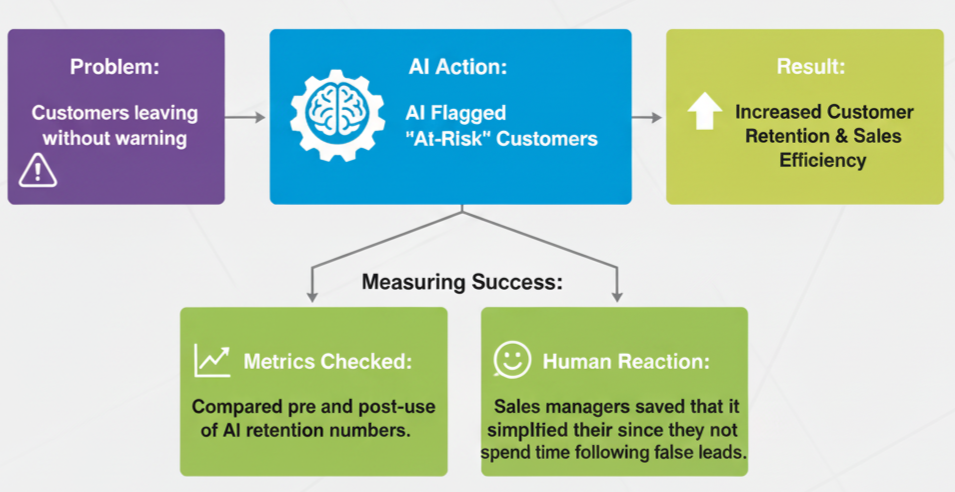
2. Banking: Catching Fraud in Real Time

3. Logistics: Smarter Delivery Routes
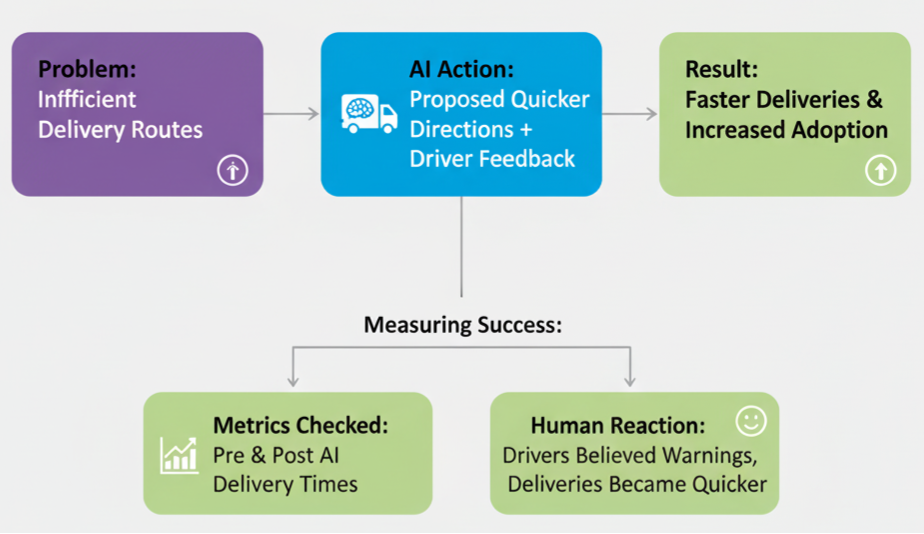
4. Manufacturing: Preventing Machine Breakdowns
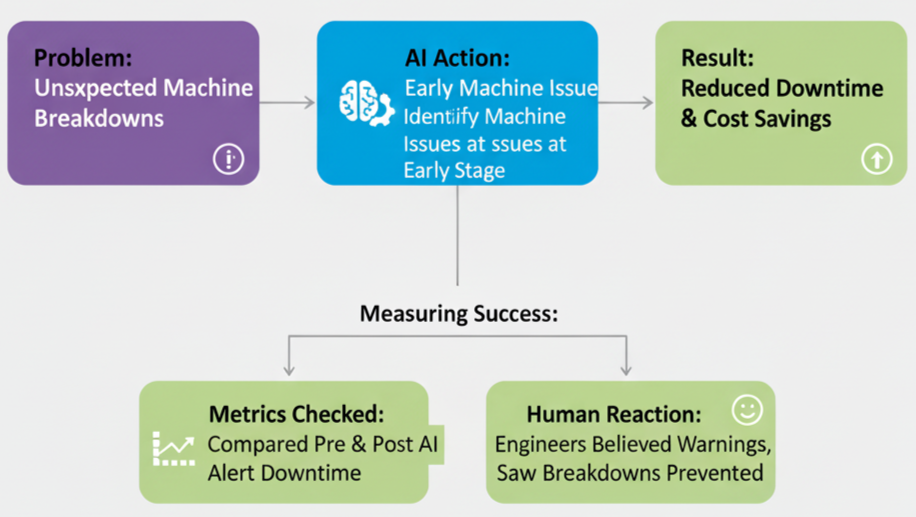
5. Healthcare: Saving Doctors' Time
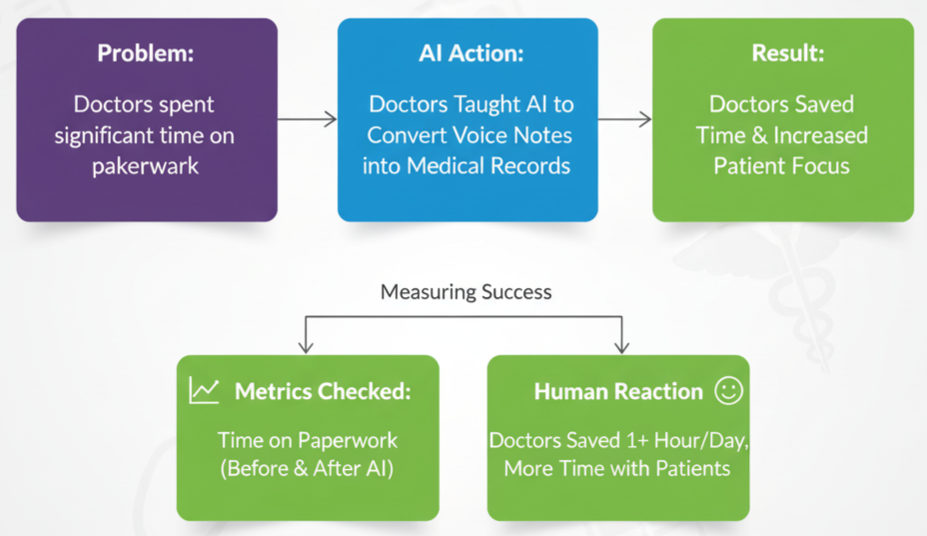
Common Challenges in Scaling AI
It is not merely about technology when scaling AI. Procedures and individuals are also important. Some common hurdles include:
- Handling scale: Can the system process millions of records reliably?
- Data security & compliance: Does it comply with legislation such as GDPR or HIPAA?
- Trust & clarity: Does AI justify a decision?
- Team adoption: Do the employees consider AI a tool of support and not danger?
👉 Example: A shipping firm noticed drivers who opposed AI pathways. Their feedback was then added and adoption increased, and delivery was quicker.
Key Takeaways
- A prototype shows what’s possible.
- Production AI shows what’s valuable.
- Scaling ensures the whole organization benefits.
- Accuracy is as important as user trust, good communication, and feedback loops.
Final Thought: It is not the number of prototypes that the company builds that makes it the real winner of AI. They transform a working idea into a consistent system that the business applies, making a real difference in performance, cost reduction, and customer satisfaction.
Ready to scale your AI projects beyond prototypes? Ellocent Labs’ expert team can help your enterprise deploy dependable AI solutions that generate real value. Contact us today to start your AI transformation journey.

Generative AI vs Traditional AI: Which is Right for Your Business?
<p>Artificial Intelligence (AI) has changed the way companies start innovating, work, and compete. But in 2026, AI will not be a solution to everything. Businesses are now presented with a major choice: they can either go with the new <strong><a href="https://www.ellocentlabs.com/services/artificial-intelligence">Generative AI</a></strong>, the up-and-coming technology responsible for ChatGPT and DALL·E, or keep using <strong>Traditional AI</strong>, the established technology that drives recommendation systems, fraud detection, and predictive analytics.</p> <p>The two categories of AI address various issues and present different values. In this article, we will break down the differences, conduct a cost-benefit analysis, and help you make an informed decision on which one best fits your business.</p> <h2><strong>What is Traditional AI?</strong></h2> <p><strong>Traditional AI</strong> focuses on <strong>pattern recognition</strong>, <strong>classification</strong>, and <strong>prediction</strong> based on structured information and rule-based systems. It uses past data to learn and make right predictions within a clear scope.</p> <h3><strong>Key Features:</strong></h3> <ul> <li>Works with structured data (numbers, labels, historical records)</li> <li>Rule-based algorithms and statistical models</li> <li>Great for predictive analytics, optimization, and classification</li> <li>Requires domain-specific data preparation and training</li> </ul> <h3><strong>Examples in Business</strong></h3> <ul> <li>Works with structured data (numbers, labels, historical records)</li> <li>Rule-based algorithms and statistical models</li> <li>Great for predictive analytics, optimization, and classification</li> <li>Requires domain-specific data preparation and training</li> </ul> <p><span style="color:#000000"><img alt="Generative AI " src="https://blogs.ellocentlabs.com/wp-content/uploads/2025/09/image-edited-scaled.png" style="height:548px; width:730px" /></span></p> <h2><strong><strong>What is Generative AI?</strong></strong></h2> <p><strong>Generative AI</strong> uses <strong>large-scale machine learning models</strong> (like GPT, Stable Diffusion, or Claude) to create new content: text, images, code, audio, and even video. Not only can it find patterns in evidence, but can generate new outputs to feed prompts.</p> <h3><strong>Key Features:</strong></h3> <ul> <li>Works with both structured and unstructured data</li> <li>Generates human-like text, images, and media</li> <li>Leverages <a href="https://www.ellocentlabs.com/services/artificial-intelligence/development-of-llm">LLMs</a> (Large Language Models) and foundation models</li> <li>Enables conversational AI, content creation, and ideation</li> </ul> <h3><strong>Examples in Business:</strong></h3> <ul> <li>Chatbots and virtual assistants (customer support)</li> <li>Automated content creation (blogs, product descriptions, marketing copy)</li> <li>Code generation for faster <a href="https://www.ellocentlabs.com/services/custom-web-development">software development</a></li> <li>Drug discovery and molecule design in healthcare</li> </ul> <h2><strong><strong>Cost-Benefit Analysis (2026 Outlook)</strong></strong></h2> <h3><strong>1. Development Cost & Resources</strong></h3> <ul> <li><strong>Traditional AI</strong>: Less specialized data, less infrastructure, and smaller models are required. Less expensive to implement and limited in scope.</li> <li><strong>Generative AI</strong>: High upfront costs (LLM training/integration, GPUs, APIs). However, pre-trained models (OpenAI, Anthropic, Hugging Face) lower the barrier.</li> </ul> <p>Choose <strong>Traditional AI</strong> if your goal is efficiency.<br /> <strong>Generative AI</strong> should be used in cases of innovation and involvement.</p> <h3><strong>2. Speed of Deployment</strong></h3> <ul> <li><strong>Traditional AI</strong>: Faster deployment for predictive use cases with structured data.</li> <li><strong>Generative AI</strong>: APIs can be readily integrated quickly (pre-trained), although more fine-tuning is required to support enterprise-specific applications.</li> </ul> <p><strong>Traditional AI</strong>: best for companies with structured historical data.<br /> <strong>Generative AI</strong>: best for companies seeking customer-facing apps.</p> <p><strong>3. Scalability & Flexibility</strong></p> <ul> <li><strong>Traditional AI</strong>: Scales well in the limited scope it is used in but cannot handle unstructured data.</li> <li><strong>Generative AI</strong>: Scales across departments—from HR (resume screening bots) to marketing (ad generation).</li> </ul> <p>📌 <em>Example</em>: A <strong>demand forecasting</strong> done by the traditional AI can be used by an <a href="https://www.ellocentlabs.com/services/no-code-platform/e-commerce-marketplace">e-commerce</a> company but the other AI-based applications can be implemented through generative AI, <strong>AI-based product description and chatbots</strong>.</p> <h3><strong>4. Accuracy vs Creativity</strong></h3> <ul> <li><strong>Traditional AI</strong>: Prioritizes accuracy, rules, and deterministic outputs.</li> <li><strong>Generative AI</strong>: Will focus on creative and contextual generation, but can give hallucinations (plausible but false result).</li> </ul> <p>Use <strong>Traditional AI</strong> where accuracy is important (finance, <a href="https://www.ellomed.com/">healthcare</a>).<br /> Use <strong>Generative AI</strong> where creativity and engagement matter (marketing, product design).</p> <h3><strong>5. Security & Compliance</strong></h3> <ul> <li><strong>Traditional AI</strong>: This type of AI is simpler to manage because it is based on structured data the company owns.</li> <li><strong>Generative AI</strong>: poses a threat to intellectual property, data privacy, and bias. Needs a more governing force.</li> </ul> <p>📌 <em>Example</em>: A hospital can implement <strong>traditional AI</strong> to support diagnosis and pilot <strong>generative AI</strong> to implement patient communicators.</p> <h2><strong><strong>Where Traditional AI Wins in 2026</strong></strong></h2> <ul> <li>Fraud detection & risk scoring in fintech</li> <li>Predictive analytics for sales & operations</li> <li>Quality control in manufacturing</li> <li>Supply chain demand forecasting</li> <li>Any use case requiring <strong>high accuracy & low tolerance for errors</strong></li> </ul> <h2><strong><strong>Where Generative AI Wins in 2026</strong></strong></h2> <ul> <li>AI-powered customer service (chatbots, virtual assistants)</li> <li>Personalized campaigns (ad copy, automation of marketing)</li> <li>Content generation (blogs, reports, social media posts)</li> <li>Product design/innovation (prototyping, ideation)</li> <li>Healthcare R&D (drug discovery, patient education tools)</li> </ul> <h2><strong>The Hybrid Approach: Generative + Traditional AI</strong></h2> <p>Forward-thinking businesses don’t see this as an <strong>either/or</strong> choice. They would rather combine the two methods to use the best.</p> <p><strong>Example</strong>:</p> <ul> <li>A bank can apply <strong>traditional AI</strong> to fraud detection.</li> <li><strong>Generative AI</strong> can also be applied by the same bank to generate individual customer financial advice reports.</li> </ul> <p>Together, they provide <strong>accuracy + engagement</strong>.</p> <h2><strong>Decision-Making Framework: Which AI is Right for Your Business?</strong></h2> <p><strong>Ask these questions before deciding</strong>:</p> <ol> <li>What problem are we solving — prediction or creation?</li> <li>Do we work primarily with structured or unstructured data?</li> <li>Is accuracy or creativity more important?</li> <li>How much money do we have to spend on AI infrastructure and APIs?</li> <li>Are we ready to have governance, compliance and ethical issues?</li> </ol> <ul> <li><strong>Pick Traditional AI</strong> → are efficiency, accuracy, and predictive insights your business drivers.</li> <li><strong>Pick Generative AI</strong> → if engagement, personalization, and innovation matter most.</li> <li><strong>Pick Both</strong> → if you want a long-term AI strategy.</li> </ul> <h2><strong>Conclusion</strong></h2> <p>In 2026, businesses no longer ask whether to adopt AI but which type of AI is right for them. <strong>Traditional AI</strong> remains the backbone of predictive analytics and operational efficiency, while <strong><a href="https://www.ellocentlabs.com/services">Generative AI</a></strong> is rewriting the rules of creativity, customer engagement, and automation.</p> <p>The smartest organizations will adopt a <strong>hybrid AI strategy</strong>—leveraging traditional AI for <strong>accuracy and optimization</strong> while harnessing generative AI for <strong>innovation and differentiation</strong>.</p> <p>By 2026, the question of whether a business should embrace AI is a thing of the past, but every business is asked what type of AI fits them. <strong>Generative A</strong>I is a complete rewrite of the rules of creativity, customer engagement, and automation, but <strong>traditional AI</strong> is still the foundation of predictive analytics and operational efficiency.</p> <p>The most intelligent organizations will pursue a hybrid approach to AI use, combining traditional AI with <strong>precision and efficiency</strong> and generative AI with <strong>innovation and differentiation.</strong></p>

Agile UI/UX Coordination: Roles, Responsibilities and Best Practices
<p>The requirements under <a href="https://www.ellocentlabs.com/agile">Agile development </a>will not be any different, but when. This will either turn into a nightmare or a chance of the designers of the UI/UX. It lies in the structure of the design process. The product will not be shaky, inconveniencing, and difficult to modify even though the requirements are to be changed as it is planned by a well-planned UI/UX.</p> <h2><strong>Shaping a Reusable Foundation</strong></h2> <p>In Agile as a UI/UX designer, one of the most intelligent things I would do will be to develop default design items, which will be uniform throughout the product. These reusable units which are buttons, input fields, modals, and patterns of navigation are the DNA of the design system.</p> <ul> <li>They are also useful in time savings as they do not need to rework each time they start off on a sprint.</li> <li>They offer a visual homogeneity of the product.</li> <li>They make the task of the developers easier because they would not be required to go through the new design repeatedly.</li> </ul> <p>And consider it to be the creation of a design language, which never loses its grammar, but gains it.</p> <h2><strong>Paper to Prototype Drafting Process</strong></h2> <p>In Agile, speed matters. That is why it is better to start with rough drafts and plunge into tools.</p> <p><img alt="layout-prototype-process" src="https://blogs.ellocentlabs.com/wp-content/uploads/2025/09/paper-to-prototype-1024x351.webp" style="height:250px; width:730px" /></p> <p><strong>Step 1:</strong> Paper and pencil, Plus Raw and unrefined test of user flows and positioning of constituents.</p> <p><strong>Step 2:</strong> Low-fidelity wireframes: Finding meaning without thinking of design.</p> <p><strong>Step 3:</strong> Illustrate drafts in working interfaces with the help of Figma prototyping.</p> <p>It implies that this stratified design suggests that the designs will be tested during the early phases and will be enhanced later during the extensive rework costs will be saved in the long-term.</p> <h3><strong>Case in Point: Ellomed</strong></h3> <p><a href="https://www.ellomed.com/"><img alt="ellomed-dashboard" src="https://blogs.ellocentlabs.com/wp-content/uploads/2025/09/ellomed-dashboard-1024x505.webp" style="height:360px; width:730px" /></a></p> <p>In the case of <a href="https://www.ellomed.com/" rel="noreferrer noopener" target="_blank"><strong>Ellomed</strong></a> (a system of Electronic Health Records), the project was originally created with a straightforward concept of managing the physicians, clinics, and appointments. However, according to Agile, the requirements continued to be updated, such as pharmacy integration, patient documents, inventory management, etc.</p> <h2><strong>UI/UX coordination helped in keeping the system on track; it did so in the following manner:</strong></h2> <ul> <li><strong>Reusable Components:</strong> We specified the standard fields, dashboard cards, buttons, alerts, etc. They did not improve on their components by reusing them when introducing new features. This enhanced the integration as well as productivity of the UI.</li> <li><strong>Stability Over Adaptability:</strong> The evolving needs did not bring about the destruction of the already existing module but how to insert the other modules and not to completely break down the existing one.</li> <li><strong>A good disposition to the user:</strong> The designs were all tested on a real user need basis. A case in point is in the pharmacy module where the date of drugs was automatically highlighted in red where it had expired. It was not all that was related to the aesthetic element, but simplifying and accelerating working processes.</li> </ul> <p>Concisely, the need to start afresh was not the foundation of the sound basis of design adaptability.</p> <h2><strong>Ideas of Agile Best Practices of UI/UX Designers</strong></h2> <p><img alt="agile-best-practices" src="https://blogs.ellocentlabs.com/wp-content/uploads/2025/09/ideas-scaled.webp" style="height:250px; width:730px" /></p> <ul> <li><strong>Design for Reusability</strong>: Early analysis of component library. Imagine it to be your LEGO box, you can do anything with it, but the pieces are the same.</li> <li><strong>Stay One Sprint Ahead</strong>: Plan the next sprint as the current one being developed. This will make sure that it is not rushed.</li> <li><strong>Collaborate Continuously</strong>: Keep up with BAs, developing and testing. Five minutes talk will save five days of re-work.</li> <li><strong>Prototyping and Diagnosing more quickly</strong>: The correct moment will never be to wait, to get feedback regarding drafts, and to click prototypes whenever it is possible.</li> <li><strong>Stability and Adaptability Consistency</strong>: These design principles must be accommodated to cater to the new needs in a non-imposing manner.</li> </ul> <h2><strong>Conclusion</strong></h2> <p>Agile does not require the presence of UI/UX coordination in order to make interfaces appealing. It is concerning the way of developing systems that could fit the change and still remain themselves. The designers are able to cope with the challenges that occur due to change of requirements, which they could center on reusable components, draft-first design, and constant teamwork, hence, transform it into an opportunity, rather than a failure.</p> <p>Practical experience with enterprises indicated that structured UI/UX causes agility to become a natural process – and the final result is not only an efficient system, but also a stable and easy to use system, coupled with being able to survive into the future.</p> <p>Transform your UI/UX collaboration with Agile best practices. Ellocent Labs offers tailored workshops and hands-on support. <a href="https://www.ellocentlabs.com/contact-us" rel="noreferrer noopener" target="_blank">Get started now </a>for more efficient, adaptable interfaces.</p>

Pros and Cons of Custom Web Design vs. Template Web Design
<p>The decision between a template and a <a href="https://www.ellocentlabs.com/services/custom-web-development">custom web </a>design is based on your budget, schedule, and business objectives. Custom web designs are tailored to your brand, offering enhanced scalability, security, and long-term growth flexibility. In contrast, templates enable rapid, low-cost launches with basic features.</p> <h2><strong>Template Web Design:</strong></h2> <h3><strong>Pros:</strong></h3> <ul> <li><strong>Budget-Friendly: </strong>Templates are affordable, particularly for new and small enterprises. You don’t have to spend a lot of money on design and development to launch a respectable-looking website.</li> <li><strong>Ready to Launch:</strong> Just add content and make minor adjustments before launching the templates. They are therefore perfect for companies seeking a rapid online presence.</li> <li><strong>Requires Minimal IT Help: </strong>You can avoid hiring developers by using drag-and-drop builders and easy customization tools, which allow anyone with rudimentary computer skills to set up a website.</li> <li><strong>Reliable Updates: </strong>To keep your website operating smoothly, designers frequently update templates to stay compatible with the newest web standards and technologies.</li> <li><strong>Wide Range of Options:</strong> Whether you’re a blogger, restaurant owner, or retailer, there’s probably a theme that will work for you among the hundreds of themes available for various industries.</li> <li><strong>User-Friendly Plugins: </strong>The majority of templates allow for the addition of practical features without knowing any code, thanks to support for well-known plugins like image sliders, social media feeds, and contact forms.</li> <li><strong>Third-Party App Integration: </strong>To help you manage your business efficiently, templates typically offer built-in integration with necessary apps like analytics, email marketing tools, and payment gateways.</li> <li><strong>Clear Structural Layout: </strong>Templates offer an organized framework that makes it simpler to edit and arrange your content by assisting you in visualizing how your website will appear.</li> </ul> <p><img alt="Template Web Design" src="https://blogs.ellocentlabs.com/wp-content/uploads/2025/05/image-2.png" style="height:413px; width:735px" /></p> <h3><strong>Cons:</strong></h3> <ul> <li><strong>Lack of Uniqueness: </strong>Your website may resemble that of others, as numerous companies utilize the same templates, thereby making it difficult to distinguish oneself in a competitive market.</li> <li><strong>Limited Customization: </strong>If the template has locked features, you might not be able to modify certain components, such as layout or functionality, to meet your precise requirements.</li> <li><strong>Limited Functionality: </strong>You might not be able to provide distinctive user experiences if you don’t support advanced features like product filtering or custom booking systems.</li> <li><strong>Security Issues: </strong>Many templates rely on third-party plugins that may not receive regular updates, which can leave your website vulnerable to malware or hacking attempts.</li> <li><strong>Not Always Friendly to SEO: </strong>Some templates contain poorly organized or bloated code, which can lower the visibility and ranking of your website in search results.</li> <li><strong>May Not Be Fully Mobile-Responsive: </strong>Poor user experiences and increased bounce rates on mobile devices may result from templates that don’t adapt well to smartphones and tablets.</li> <li><strong>Limited Support: </strong>If the template is free or was created by a small team without a dedicated help desk, you might have trouble getting technical support.</li> <li><strong>Lacks Professional Feel: </strong>Custom-built websites may appear more polished and brand-aligned than template-based ones, which may affect how people view your company.</li> </ul> <h2><strong>Custom Web Design:</strong></h2> <h3><strong>Pros:</strong></h3> <ul> <li><strong>Unique and Branded Design: </strong>Your website is created from the ground up to reflect the essence of your business, giving you a genuinely unique appearance and feel that makes you stand out.</li> <li><strong>Flexible and Adaptable:</strong> All aspects of the website, including features and layout, are completely customizable. This makes sure your website works the way you want it to.</li> <li><strong>Tailored to Business Needs: </strong>Whether you require particular user journeys, integrations, or performance enhancements, custom websites are constructed around your objectives.</li> <li><strong>Improved User Experience: </strong>By streamlining the user journey for your audience, you can make the website quick, easy, and pleasurable, which will increase engagement and conversions.</li> <li><strong>SEO-Friendly Architecture: </strong>Custom designs make use of <a href="https://www.ellocentlabs.com/services/digital-marketing/search-engine-optimization">SEO</a> best practices and clean, optimized code, increasing the likelihood that your website will rank higher in search engine results.</li> <li><strong>Highly Customizable Features:</strong> Include intricate components made especially for your audience, such as interactive product catalogs, booking engines, or custom calculators.</li> <li><strong>Scalable for Growth:</strong> A specially designed website can readily expand to accommodate your company’s needs. You don’t have to start over when adding new features, sections, or integrations.</li> <li><strong>Increased Security: </strong>Custom websites are more secure and less hackable when developers limit third-party plugins and follow stricter coding techniques.</li> </ul> <p><img alt="Custom Web Design" src="https://blogs.ellocentlabs.com/wp-content/uploads/2025/05/image-1.png" style="height:417px; width:626px" /></p> <h3><strong>Cons:</strong></h3> <ul> <li><strong>Higher Development Costs: </strong>Compared to using templates, custom design necessitates a larger financial investment due to the involvement of designers and developers.</li> <li><strong>Needs a Skilled Team: </strong>Unlike do-it-yourself options, you will need a team of professionals to design, build, and maintain your website, which may require more resources.</li> <li><strong>Requires Constant Maintenance:</strong> As technology and user demands change, a custom website will require frequent updates to stay safe and operational.</li> <li><strong>Time-Intensive Process: </strong>Creating a custom website requires patience and time, typically ranging from weeks to months, from research and wireframing to testing and deployment.</li> </ul> <h2><strong>Conclusion:</strong></h2> <p>Your short- and long-term objectives should guide your decision between a template and a custom web design. Templates are a good place to start if you need a quick, inexpensive, and easy <a href="https://www.ellocentlabs.com/solutions">solution</a>. However, if you want a digital presence that is highly professional, scalable, and brand-focused, investing in a custom-built website will provide the performance and flexibility your company deserves.</p>

Scaling AI in Enterprises: From Prototype to Production in 2026
<p>AI projects can be small. We generate an idea in a team. Can we predict customer churn? Can we detect fraud? Can we improve delivery routes? We built a quick prototype (proof-of-concept) that shows promise.</p> <p>But the real challenge is not building that first model. The real issue is to make it something dependable, trusted, and used every day throughout the entire organization. It is on the path between idea and production at scale that the real worth of AI opens up.</p> <h2><strong>From Idea to Real Business Value</strong></h2> <p>A prototype will only demonstrate what can be done. Production <a href="https://www.ellocentlabs.com/services/artificial-intelligence">AI</a> proves what’s valuable. To move forward, organizations must show that the system can help in <strong>real-world use cases</strong>.</p> <p>Take a retail company. Their prototype AI identified customers to target based on their purchase history. Precision was fine, but managers inquired: “So is this actually helping us to save customers?” In order to determine, the AI was connected to their CRM, thereby enabling their sales teams to receive real-time notifications. In the near future, there was an increase in the number of reps who targeted the right customers and retention.</p> <p><strong>👉 Lesson:</strong> It does not matter how accurate you are. When connected to the day-to-day business operations, value will ensue when AI is involved.</p> <h2><u><strong><strong><a href="https://www.ellocentlabs.com/industries/enterprise">Real-World Scenarios of Scaling AI</a></strong></strong></u></h2> <p>Here’s how different industries moved from prototypes to production systems:</p> <h3><strong>1. Retail: Keeping Customers from Leaving</strong></h3> <p><img alt="Retail: Keeping Customers from Leaving" src="https://blogs.ellocentlabs.com/wp-content/uploads/2025/09/Retail-Keeping-Customers-from-Leaving-1.png" style="height:376px; width:730px" /></p> <h3><strong>2. Banking: Catching Fraud in Real Time</strong></h3> <p><img alt="Banking: Catching Fraud in Real Time" src="https://blogs.ellocentlabs.com/wp-content/uploads/2025/09/Banking-Catching-Fraud-in-Real-Time.png" style="height:438px; width:730px" /></p> <h3><strong>3. Logistics: Smarter Delivery Routes</strong></h3> <p><img alt="Logistics: Smarter Delivery Routes" src="https://blogs.ellocentlabs.com/wp-content/uploads/2025/09/Logistics-Smarter-Delivery-Routes.png" style="height:422px; width:730px" /></p> <h3><strong>4. Manufacturing: Preventing Machine Breakdowns</strong></h3> <p><img alt="Manufacturing: Preventing Machine Breakdowns" src="https://blogs.ellocentlabs.com/wp-content/uploads/2025/09/Manufacturing-Preventing-Machine-Breakdowns.png" style="height:412px; width:730px" /></p> <h3><strong>5. Healthcare: Saving Doctors' Time</strong></h3> <p><img alt="Healthcare: Saving Doctors’ Time" src="https://blogs.ellocentlabs.com/wp-content/uploads/2025/09/Healthcare-Saving-Doctors-Time.png" style="height:422px; width:730px" /></p> <h2><strong>Common Challenges in Scaling AI</strong></h2> <p>It is not merely about technology when scaling AI. Procedures and individuals are also important. Some common hurdles include:</p> <ul> <li><strong>Handling scale:</strong> Can the system process millions of records reliably?</li> <li><strong>Data security & compliance:</strong> Does it comply with legislation such as GDPR or HIPAA?</li> <li><strong>Trust & clarity:</strong> Does AI justify a decision?</li> <li><strong>Team adoption:</strong> Do the employees consider AI a tool of support and not danger?</li> </ul> <p><strong>👉 Example: </strong>A shipping firm noticed drivers who opposed AI pathways. Their feedback was then added and adoption increased, and delivery was quicker.</p> <h3><strong>Key Takeaways</strong></h3> <ul> <li>A <strong>prototype</strong> shows what’s possible.</li> <li><strong>Production AI</strong> shows what’s valuable.</li> <li><strong>Scaling</strong> ensures the whole organization benefits.</li> <li>Accuracy is as important as user trust, good communication, and feedback loops.</li> </ul> <p><strong>Final Thought:</strong> It is not the number of prototypes that the company builds that makes it the real winner of AI. They transform a working idea into a consistent system that the business applies, making a real difference in performance, cost reduction, and customer satisfaction.</p> <p>Ready to scale your AI projects beyond prototypes? Ellocent Labs’ expert team can help your enterprise deploy dependable AI solutions that generate real value. <a href="https://www.ellocentlabs.com/contact-us"><strong>Contact us</strong></a> today to start your AI transformation journey.</p>

SEO Trends 2025: Making Your Brand Shine with AIO, GEO, AEO and SXO
<p>The online world is always changing, and 2025 is a big year for how businesses get found on search engines. You might hear some people say, “SEO is dead,” but that’s not true at all! Instead, <a href="https://www.ellocentlabs.com/services/digital-marketing/search-engine-optimization">SEO</a> is simply growing and changing, mostly because of Artificial Intelligence (AI) in search. This isn’t a problem; it’s a huge chance for those who are ready to learn and adapt. Google isn’t just counting keywords anymore; it’s looking at how good your content is, what it means, and how easy it is for people to use.</p> <p>To do well in this new world, businesses need to go beyond old SEO tricks. They need to use a smarter, more connected way of thinking. This means understanding and combining four key ideas: <strong>AI Optimization (AIO)</strong>, <strong>Generative Engine Optimization (GEO)</strong>, <strong>Answer Engine Optimization (AEO)</strong>, and <strong>Search Experience Optimization (SXO)</strong>. These techniques, when used together, are vital for keeping your company prominent and competitive online.</p> <p>The traditional notion of simply “ranking” high is evolving. Today, it’s more a question of “being the answer” or “being mentioned” by machines. This implies that success is no longer merely the click on a blue link. It is about being the authoritative source that a machine mentions. This alters the manner in which companies define success and strategize their content.</p> <h2><strong>Understanding the New SEO Terms</strong></h2> <p><img alt="" src="https://blogs.ellocentlabs.com/wp-content/uploads/2025/06/seo-trends-2025-1024x585.webp" style="height:417px; width:730px" /></p> <p>Let’s break down these new terms to see how they fit into the future of SEO.</p> <h3><strong>AIO: AI Optimization </strong></h3> <p>Making your website’s content simple for AI-driven search engines to comprehend and summarize is the main goal of AI Optimization (AIO). Consider it a way to make your material “machine-readable.” Google’s AI Overviews, which provide instant responses directly on the search page, are expanding. This suggests that fewer people might visit your website. However, Google is making these AI Overviews more link-rich, so even if your website is small, it will still be seen. Getting your brand recognized and highlighted in these AI summaries is now the primary goal, rather than simply generating clicks.</p> <h2><strong>GEO: Generative Engine Optimization</strong></h2> <p>Generative Engine Optimization (GEO) is all about creating your content in such a high quality that AI tools like Google’s Search Generative Experience (SGE) prefer to use it when they generate their answers. It’s all about being the go-to source that AI quotes or mentions. Unlike classical SEO, which desires a click, GEO desires your content to be “the answer” itself. This is to say that your content must be extremely clear, credible, and display actual expertise. <a href="https://www.ellocentlabs.com/services/artificial-intelligence">AI</a> adores unique insights, original research, and facts that it simply can’t manufacture on its own.</p> <h3><strong>AEO: Answer Engine Optimization</strong></h3> <p>Answer Engine Optimization (AEO) focuses on making your content give direct, short answers to people’s questions. This helps your content show up in “featured snippets” (those quick answer boxes at the top of Google), “People Also Ask” sections, and especially in voice search results. With devices like Alexa and Siri, people get spoken answers without seeing website links. So, being the main source for an answer engine not only makes you more visible but also shows your brand as a trusted expert. AEO means using natural language and answering questions directly, often in a Q&A style.</p> <h3><strong>SXO: Search Experience Optimization</strong></h3> <p>Search Experience Optimization (SXO) involves marrying traditional SEO with the way users really behave on your site (User Experience or UX). Its primary purpose is ensuring that after finding your site, users have an easy, quick, and pleasant time. If your website is slow to load or difficult to navigate on mobile, users will leave quickly, regardless of your search ranking. SXO ensures your site is engaging and user-friendly, helping to keep visitors and encouraging actions like sign-ups and purchases.</p> <h2><strong>How They Work Together for Maximum Impact</strong></h2> <p>The real power of these four strategies lies in their combined use. They are not separate ideas; they work hand-in-hand to make each other stronger.</p> <ul> <li><strong>AIO</strong> lays the groundwork by making your content easy for AI to understand.</li> <li>Then, <strong>GEO</strong> uses that understanding to get your content mentioned and quoted by AI.</li> <li><strong>AEO</strong> builds on this by making your content appear as direct answers in search results and voice searches.</li> <li>Finally, <strong>SXO</strong> ensures that when people visit your site, they have a great experience, which encourages them to stay and convert.</li> </ul> <p>This creates a positive cycle: good content that AI understands leads to more mentions, which leads to more direct answers, and a great website experience keeps people happy and coming back. This combined approach helps your brand be seen and trusted everywhere online, not just in traditional search results.</p> <p><img alt="" src="https://blogs.ellocentlabs.com/wp-content/uploads/2025/06/seo-trends-1024x512.webp" style="height:365px; width:730px" /></p> <h2><strong>Simple Steps to Get Started</strong></h2> <p>To use these strategies, focus on quality, what users want, and a good technical setup:</p> <ul> <li><strong>Create Great Content:</strong> <ul> <li><strong>Be an Expert:</strong> Show your experience, knowledge, and trustworthiness. Mention your sources and have real experts write your content.</li> <li><strong>Keep it Clear and Short:</strong> Structure your content with clear headings, bullet points, and Q&A sections so AI can easily pull out answers.</li> <li><strong>Use Schema Markup:</strong> This is like giving AI a map of your content, helping it understand what your page is about.</li> <li><strong>Think Like a Human: </strong>Use natural, conversational language, especially for voice search.</li> </ul> </li> <li><strong>Make Your Website Fast and Easy to Use:</strong> <ul> <li><strong>Speed Matters:</strong> Make sure your website loads super fast on all devices, especially phones.</li> <li><strong>Easy to Navigate:</strong> Design your website so people can easily find what they’re looking for.</li> <li><strong>Engaging Visuals:</strong> Use good images, videos, and charts to make your content more interesting.</li> </ul> </li> <li><strong>Build Trust and Authority:</strong> <ul> <li><strong>Become a Go-To Source:</strong> Create lots of detailed content on your topic to show you’re an expert.</li> <li><strong>Get Good Links:</strong> Get links from other trusted websites.</li> <li><strong>Local SEO:</strong> If you have a physical business, make sure your Google Business Profile is updated and get local reviews.</li> </ul> </li> </ul> <h2><strong>Looking Ahead</strong></h2> <p>The world of SEO is always changing, but human expertise is still key. AI tools can help with research and content ideas, but real creativity, unique ideas, and building trust still come from people. The future of SEO is exciting, and by embracing these new, connected strategies, your business can stay ahead and truly shine online.</p>
Schedule a 15-Minutes call
Let’s make things happen and take the first step toward success!
Got Ideas? We’ve Got The Skills.
Let’s Team Up!
Let’s Team Up!
What Happens Next?
We review your request, contact you, and sign an NDA for confidentiality.
We analyze your needs and create a project proposal with scope, team, time, and cost details.
We schedule a meeting to discuss the offer and finalize the details.
The contract is signed, and we start working on your project immediately.
